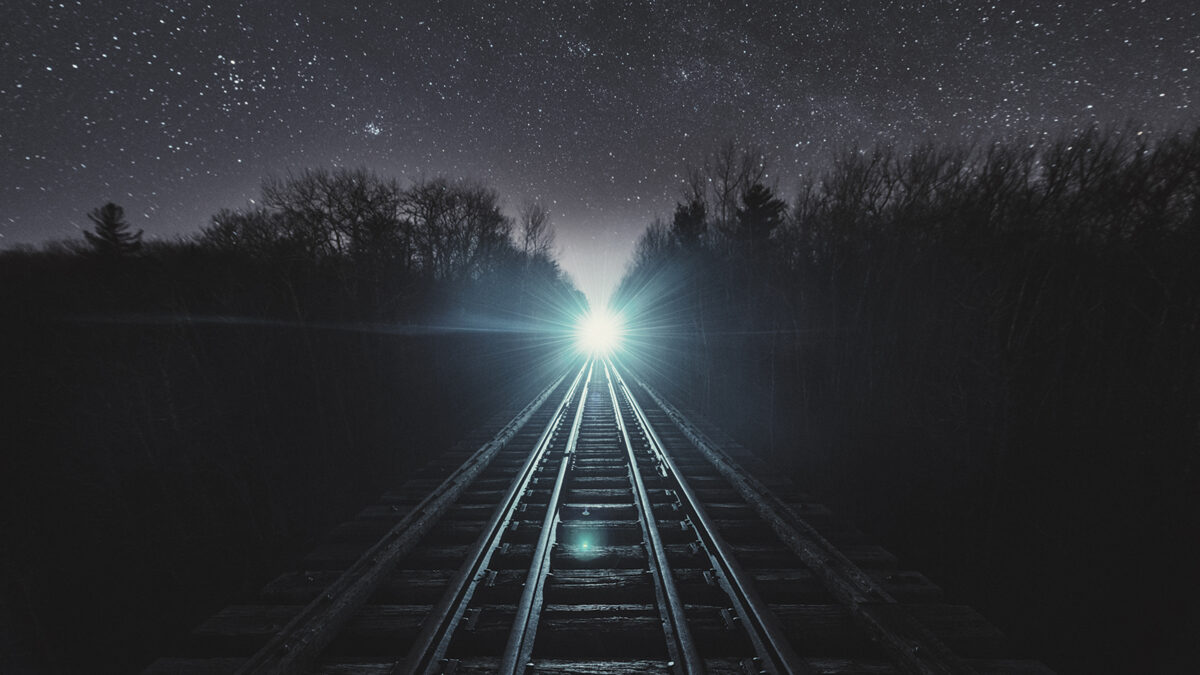
A Bitter End at the Sugar Beet Yard
June 2024
Download This Article (.pdf)
The Great Western Sugar Company (Great Western) railyard in Fort Collins was a dangerous place to work in 1906, especially after dark. The yard was poorly lit and full of hazards. But the sugar plant was so busy in November of that year that the Colorado and Southern Railway (C&SR) provided a night crew to run a second shift switching the railroad cars that handled cargo at the plant.
A spur track from the C&SR, known as the “runaround track,” entered through the plant’s western gate into the factory yard. The runaround track was connected to other tracks that crisscrossed the yard. These sidetracks were used to load and unload freight and to couple and decouple cars. Along these tracks in the yard, the train crews ran a gauntlet of nearby hazards, including a standpipe, coke bins, incline fencing, piles of limestone, and a storage shed.
Another danger arose from the string of abandoned electric light poles that ran along one section of the track. Great Western had not installed the light poles. Like the spur track, they had been placed by another sugar company before Great Western purchased the property in February 1905. The poles, tall and thick with climbing spikes driven into them, were originally used to illuminate a system of flumes that conveyed sugar beets from beet piles to the factory. Now the lights had gone dark, and the disused poles towered over the tracks in the darkness.
The Accident
On Friday, November 23, 1906, C&SR’s night crew consisted of an engineer, a fireman, a conductor, and two brakemen. One of the brakemen, Dillard R. Parker, had only been working on the night crew for about two weeks. Parker fulfilled his duties industriously, but he had become known for his recklessness. Other members of the crew had warned him “at different times to observe care and caution” in the dangerous yard, “as he appeared to be somewhat venturesome and heedless of danger.”1 The crew’s engineer had told him “he was trying to work entirely too fast around the yards,” he was taking too many chances, and if he was not more careful, “he would sooner or later get killed or hurt.”2 Parker responded that he was a new railroad employee and he was just trying to do his best. The engineer replied that he would be better off getting a daytime job around the yard to become more familiar with the hazards so he could avoid them. But there is no indication Parker pursued this suggestion.
In the early morning hours of November 24, Parker and the other men entered the yard along with a train full of limestone. They steered the train onto a track known as the “limerock track,” which was connected by a switch to the runaround track. Parker helped place the cars on the limerock track, and then walked away. Meanwhile, the others coupled the engine to four empty coal cars.
About 10 minutes later, the other brakeman on the crew, Tindall, was standing at the rear end of the car closest to the engine. A Great Western contractor named McCorkle then signaled to Tindall to start the train, and Tindall passed on the signal to the engineer.
The train started out of the yard. The yard was dark, with only a few faint light sources nearby. There was an electric light on a pole near the limerock track. There was also a dim reflection from the factory lights, light from the lanterns carried by the brakemen and McCorkle, and the beam emanating from the train’s headlight.
As it rolled forward, the train passed by the most easterly of the abandoned light poles. This pole was about four and a half feet from the south rail of the runaround track. The coal cars overhung the rail by just over two feet, leaving only a couple of feet to spare for anyone hanging from the south side of the car from its grabrail and footrest. To make things worse, at least one of the climbing spikes protruded toward the track and narrowed this gap by another six inches.
The other men had not seen Parker since the limestone was unloaded. It was unclear at first whether he was riding on the coal train. The conductor later testified that when he stepped on the brake beam of the rear car, he saw two lanterns ahead of him, one near the engine and the other about midway down the train, on the south side. He thought the lantern on the south side could have been Parker’s. Tindall, the other brakeman, said he also saw a lantern on the south side of the train when it started up, but that lantern later disappeared.
After it passed the easternmost light pole, the train traveled another 600 to 700 feet and exited the yard. There, the rear car of the train derailed. The crew stopped the train. When they examined the scene, they made a gruesome discovery.
Parker’s body rolled out from under the car. Following the skid marks in the snow, they could see he had been dragged for over 500 feet, beginning at a point three feet west of the eastern light pole. At that point, the impression in the snow looked as if it had been “made by a man’s body falling, or sliding or slipping down into the snow.”3 An examination of the body the next morning revealed “a mark on his right cheek, about the size of the print of a man’s thumb” and Parker’s “right arm was broken in two places, and there was a gash or hole across the small of his back.”4
A coroner’s jury concluded that Parker had died accidentally while working for the C&SR when his body struck a light pole or the spike protruding from it.5 The jury also opined that the pole was located too close to the train to be safe for railroad employees.
Parker was a member of the Elks Lodge of Carthage, Missouri. The Fort Collins Elks Lodge assisted Parker’s widow, Bessie R. Parker, with transporting his body back to his hometown in Carthage, where he was buried.6
The Lawsuit
Parker’s widow sued both Great Western and C&SR. Her complaint charged that along the spur track,
the defendants erected, or permitted to be erected and maintained, a certain pole or series of poles, with iron spikes or bars projecting therefrom toward said track, which pole or poles were negligently erected, or permitted to be erected, so close to said track as to endanger the lives or person of those operating the trains thereon.7
The complaint further alleged that Parker had been “riding on the side of one of the cars, when he was struck by one of said poles, or a spike projecting therefrom, and thereby thrown under the train of cars and killed.”8 Finally, it was alleged that the train “was operated at a high and negligent rate of speed by the railway company’s employees.”9
The case proceeded to trial. A jury returned separate verdicts against both defendants. Its verdict against C&SR was exactly twice the amount of the verdict against Great Western. But the trial court rejected the separate verdicts and sent the jury back for further deliberations. The jury then returned with a verdict against both defendants jointly for the single sum of $4,250.10 The trial court denied the defendants’ motion for a new trial, and they appealed.
The Appeal
Although the defendants were permitted to file separate appeals, the Colorado Supreme Court later ordered the appeals consolidated and denied Ms. Parker’s motion to dismiss the appeals. They were then assigned to the Colorado Court of Appeals.
The court of appeals first rejected out of hand Great Western’s argument that the complaint failed to state a claim. It then turned to Great Western’s highly technical argument that the trial court had erred in rejecting the defendants’ motion to require Ms. Parker to elect between two causes of action supposedly contained in the complaint, one of which she had brought against both defendants and the other against C&SR alone. The court determined that liberally construed, the complaint stated a single cause of action against both defendants that rested on a negligence theory. The complaint’s separate allegation against C&SR alone, that the train was supposedly being driven at an excessive rate of speed, was unsupported by the evidence and “was expressly eliminated from the case by an instruction given by the court.”11
The court then turned to the main issue on appeal, the jury instructions. There were 37 of them, laying out both the plaintiff’s theory of liability and the defendants’ defenses. Those defenses focused on Parker’s alleged contributory negligence and assumption of the risk. Such defenses against workers asserting claims for on-the-job injuries were typical before workers’ compensation laws went into effect.
Instruction Number 4 told the jury that it was C&SR’s duty to provide a reasonably safe place for its employees to work, even if the railroad did not own the jobsite but merely used it in its business. The court of appeals did not have a problem with the theory behind this instruction, which found support in several prior Colorado cases. The problem was its prejudicial effect on the jury when combined with another instruction, Number 6, which improperly told the jury that
the erection of a pole, or allowing a pole to remain, after the presence thereof should have been known, by the exercise of reasonable care, which pole is not a necessary part of or appliance or convenience or connection in the use of the track, in such close proximity, at such a place along the track as to be dangerous to the employes of the defendant, the Colorado and Southern Railway Company, is negligence per se.12
This instruction was particularly problematic because C&SR had not erected the light pole, had no control over its continued presence on the jobsite, and did not use it as part of its railroad business. The court of appeals clarified that it was not saying the fact that the tracks were on the sugar company’s premises or were used for the benefit of both Great Western and C&SR relieved C&SR from its duty to provide a safe working environment for its employees. The problem with the instructions was that they told the jury it should find C&SR negligent per se merely for knowing about the pole and its dangers, without considering its reasonable duty of care under all the circumstances.
The court of appeals also found problems with the assumption-of-the-risk instructions, which it deemed mutually contradictory. Two of the instructions told the jury that Parker assumed only those risks ordinarily and reasonably incident to his employment, of which he knew or should have known. But another instruction stated that “if he was assigned to work at an unusually or extraordinarily dangerous place, and was informed of said unusual or extraordinary dangers, or by any means learned thereof, and understood and appreciated them, such dangers became ordinary to said employment” such that he assumed their risk and if his death were due to such dangers, the plaintiff could not recover for it.13 The court of appeals held the latter instruction correctly stated the law because it embodied the principle that where the employee knows of a defective condition in his workplace, or such a defect “is so patent as to be readily observed by him, he cannot continue to use the defective apparatus in the face of knowledge and without objection, without assuming the hazard incident to such a situation.”14 The fact that the latter instruction included this principle could not repair its omission from the other assumption-of-the-risk instructions. The overall effect was likely to be that the jury was misinformed about what risks a worker may assume by working in a hazardous situation or with defective equipment.
The sugar company also objected to some of the instructions, but these appellate challenges were less successful. Great Western objected to an instruction that it was presumed to have constructive knowledge of the proximity of the pole to the tracks “provided the conditions then existing had been in existence for a sufficient length of time for the sugar company, or its agents, in the exercise of reasonable care on its part, to have learned thereof.”15 The court of appeals found no problem with this instruction, given that the proximity of the poles to the tracks could have been discovered by a reasonable inspection and the tracks were there to benefit the sugar company’s business.
The court also rejected Great Western’s objection to an instruction that if Parker and his crew went into its railyard at the sugar company’s invitation, for its or C&SR’s business, then Great Western was required to use reasonable care to ensure that its premises were reasonably safe to be used by the switching crew. This instruction correctly defined Great Western’s duty in terms of reasonable care, in a way that the assumption-of-the-risk instructions concerning C&SR’s duties did not.
Based on the erroneous instructions concerning C&SR’s liability, the court of appeals therefore reversed the trial court’s judgment and remanded the case for a new trial. It is unclear whether the Parker case was retried after the reversal.
Conclusion
Although the sugar beet industry contributed greatly to Fort Collins’s economy in the early days, the industry later faced hard times, including significant competition from the cane sugar industry. The Great Western Sugar Company facility in Fort Collins closed in 1954. The C&SR operated independently until 1908 and was eventually absorbed into the Burlington Northern Railroad.).
Notes
1. Great W. Sugar Co. v. Parker, 123 P. 670, 675 (Colo.App. 1912).
2. Id.
3. Id. at 674.
4. Id.
5. “Verdict of Coroner’s Jury in Parker Case,” Wkly. Courier (Fort Collins) at p. 11, col. 4 (Nov. 28, 1906).
6. “Body of Dillard Parker Reaches Former Home,” Wkly. Courier (Fort Collins) at p. 16, col. 5 (Dec. 5, 1906).
7. Great W. Sugar Co., 123 P. at 672.
8. Id.
9. Id.
10. “Verdict Reached in Parker Case,” Wkly. Courier (Fort Collins) at p. 11, col. 2 (May 6, 1908).
11. Great W. Sugar Co., 123 P. at 675.
12. Id. at 677 (internal quotation marks omitted).
13. Id. at 678.
14. Id. at 679 (internal quotation marks omitted).
15. Id. at 680 (internal quotation marks omitted).
Parker’s body rolled out from under the car. Following the skid marks in the snow, they could see he had been dragged for over 500 feet, beginning at a point three feet west of the eastern light pole.


